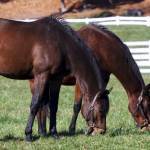Sugar Accumulation in Grass May Harm Horses

In nutrition circles, pasture grasses have been given the moniker “Dr. Green.”
Old-time veterinarians often prescribed this “remedy” to horses when an accurate diagnosis of whatever was ailing their patients was difficult to pinpoint. In past decades, it had become obvious that those old-timers knew a thing or two. Pasture grass seemed to “cure” many ailments.
More recently, however, scientists have revealed that Dr. Green may not be the best prescription for all horses. Under specific growing conditions, common pasture plants can harbor sufficient sugar to cause metabolic problems in certain horses that are especially sensitive to carbohydrates.
Through a process called photosynthesis, plants use the energy from sunlight to produce sugar and oxygen from carbon dioxide and water. During the overnight hours, plants undergo respiration, which turns fuel molecules such as sugar into energy that supports their growth. Therefore, sugar is vital for normal plant development.
Under normal conditions, sugar production and sugar usage are at similar levels so little excess sugar is stored in plant structures.
If, however, photosynthesis outpaces respiration, sugars accumulate in the plant. Respiration slows when plants experience stress due to a limited supply of any important resource that they need to grow such as water or an essential nutrient. In these instances, certain plants store sugar as fructan so that it is available for growth once the limiting resource reappears. This is why drought-stricken plants will often regain their color and grow quickly after a rain.
Not all plants accumulate fructan. It occurs in several cool season grasses that are seeded in horse pastures such as brome, orchard grass, perennial ryegrass, and fescue, though levels may vary among varieties.
Fructan-Induced Laminitis
All horses should be acclimated to lush pastures gradually. By slowly increasing the time allowed on fast-growing pasture, horses are more likely to avoid gastrointestinal and metabolic complications. If a horse or pony has experienced a previous bout of laminitis, pasture may be severely restricted or cut out altogether from the diet, depending upon the recommendation of the attending veterinarian.
Gorging on lush pastures or grasses that have been stressed due to drought or frost can set the stage for serious health problems, the grimmest of which is laminitis. Fructans, unlike many other sugars, cannot be broken down enzymatically and therefore bypass digestion in the small intestine and wind up in the hindgut to be fermented by the resident microbes. Rapid fermentation of the fructan in the hindgut causes undesirable shifts in the pH due to the production of volatile fatty acids and lactic acid. The hindgut microbial population is fragile and may not be able to adequately cope with a quick drop in pH. Massive die-offs of microbes often trigger a bout of laminitis. The severity of the laminitis depends on several factors such as the amount of fructan consumed and the sensitivity of individual horses.
Fructan-Related Subclinical Acidosis
Another complication of fructan overconsumption is subclinical acidosis. The mechanism for subclinical acidosis is similar to that described for laminitis with one important exception. Instead of a single, overwhelming incident that sends the hindgut into complete disorder and sets into motion laminitis, horses with subclinical acidosis suffer from chronic low pH and elevated levels of lactic acid. While they may not experience full-blown laminitis, they are uncomfortable, so much so that the discomfort might negatively impact attitude, performance, and overall health. Horses with chronic subclinical acidosis are predisposed to serious hindgut disorders.
Management Tactics
Proper management of subclinical acidosis, particularly in laminitis-prone horses, is key to their well-being. One management tactic involves scheduling turnout at times that coincide when fructan concentrations are thought to be lowest in plants, though this varies depending on several factors. Generally, the safest time for fructan-sensitive horses to graze is early morning after a night in which the temperature did not dip below 40°F (4°C).
The most dangerous time for these horses to graze is thought to be late afternoon or early evening when the temperature the preceding night fell below 40°F. Even moderate amounts of grain in combination with high fructan intake can increase the likelihood of hindgut disorders.
If a horse is ruled off all pasture, the next logical forage source is good-quality grass hay. This dietary adjustment will eliminate most potential problems. The only exception is in extremely sensitive horses, in which case fructan content of certain hays may be sufficient to cause problems.
Working closely with a veterinarian and an equine nutritionist is your best bet in deciding if your horse is at risk for fructan-related problems. These professionals can help you adopt a management plan that will keep your horse out of harm’s way.








